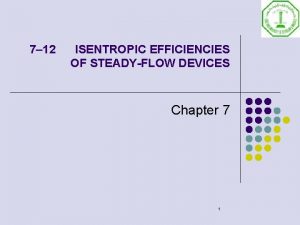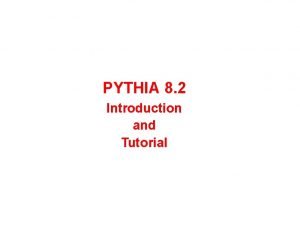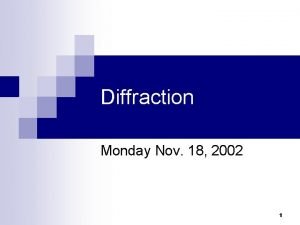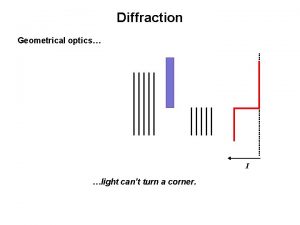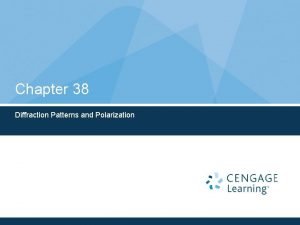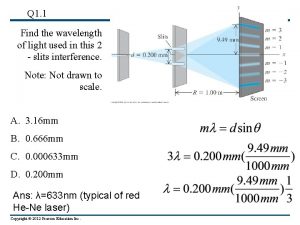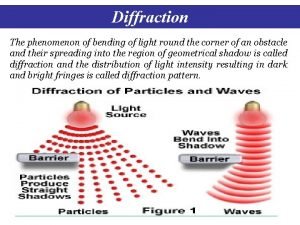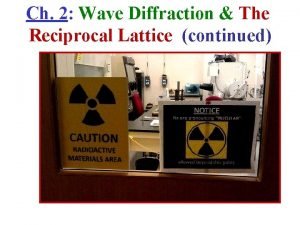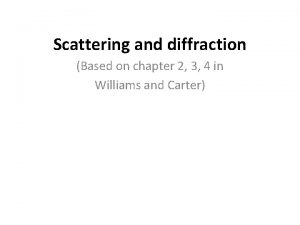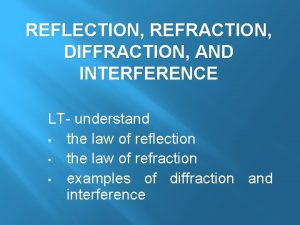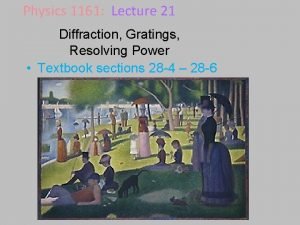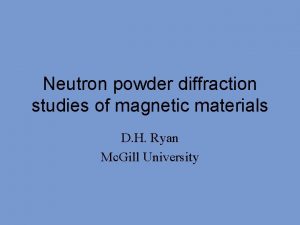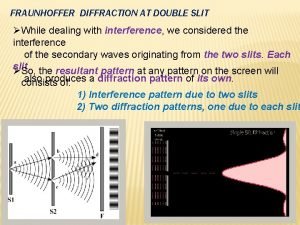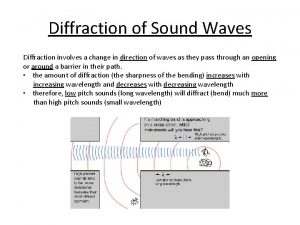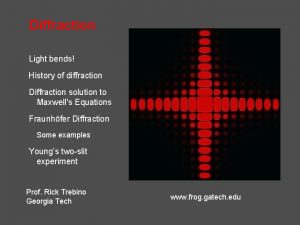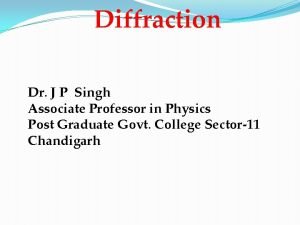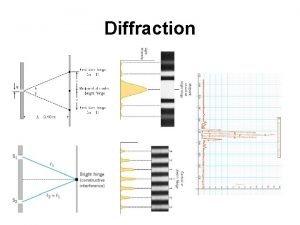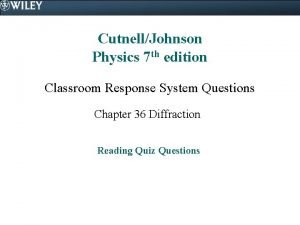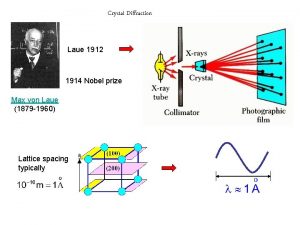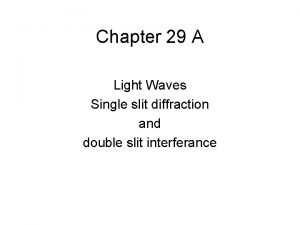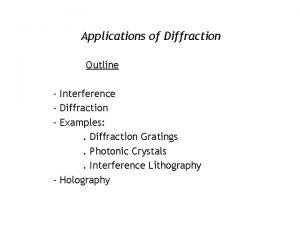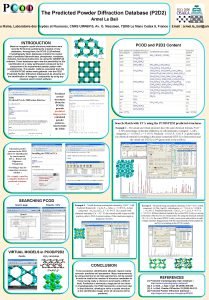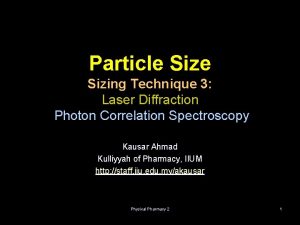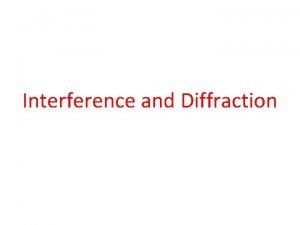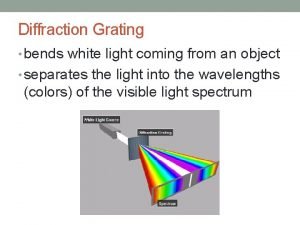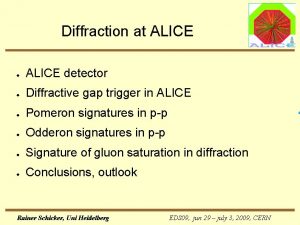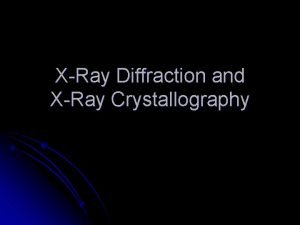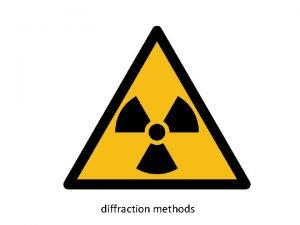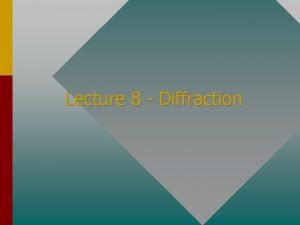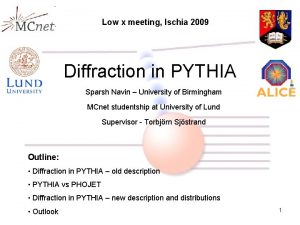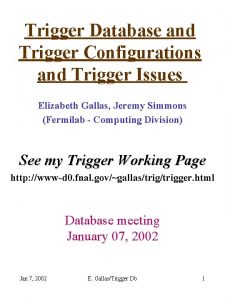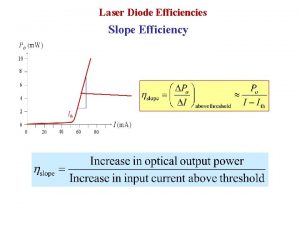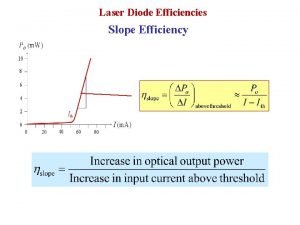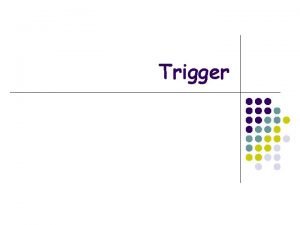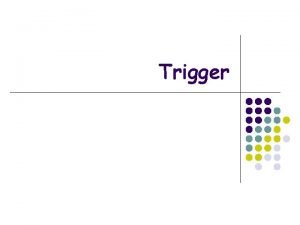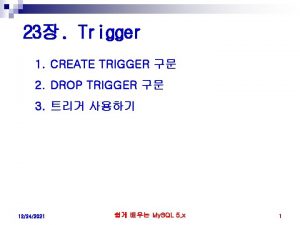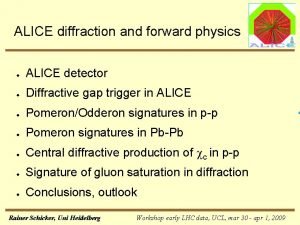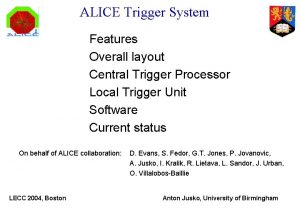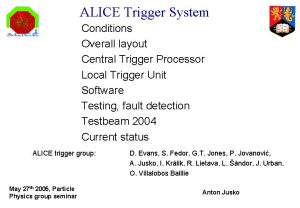Trigger Efficiencies in ALICE and Diffraction in PYTHIA



























![ALICE first paper - ar. Xiv: 0911. 5430 [hep-ex] • Trigger – atleast 2 ALICE first paper - ar. Xiv: 0911. 5430 [hep-ex] • Trigger – atleast 2](https://slidetodoc.com/presentation_image/90902016b3a8da6dbcb902f5e848313f/image-28.jpg)


- Slides: 30

Trigger Efficiencies in ALICE and Diffraction in PYTHIA Sparsh Navin – University of Birmingham for the ALICE collaboration Diffractive and electromagnetic processes at the LHC, Trento 2010

Outline ALICE and pp trigger efficiencies • ALICE detectors for first physics with protons • Process Types • First physics trigger efficiencies Diffraction and PYTHIA • Kinematic comparison – PYTHIA 6. 4 and PHOJET • Diffraction in PYTHIA – then and now • Comparison of kinematic plots – PYHTIA 8. 310 • Summary 2

A Large Ion Collider Experiment • Primary purpose – heavy ion detector for Pb-Pb collisions at 5. 5 Te. V • First physics programme is pp at 0. 9, 2. 36, 7 (maybe 10) and 14 Te. V - Time and space alignments - pp bench mark to study genuine Pb-Pb effects • Special features for pp collisions: - Low magnetic field => low p. T cut-off, tracking resolution from 100 Me. V/c - Excellent PID over broad range of momenta - Primary vertex resolution (100μm for pp, 10 μm for Pb-Pb) • pp Physics contributions: - Physics cross checks with previous results - Good description of underlying event and high multiplicity collisions • 1 st measurements: , multiplicity and momentum distributions and

A Large Ion Collider Experiment - 2 V 0 A z = 3. 3 m • Provide the V 0 A and V 0 C trigger signals • Time resolution better than 1 ns V 0 C z=-0. 9 m ITS (Inner Tracking System) • SPD – Inner layers - 3. 9 cm 7. 6 cm radii - better than 100μm resolution - provide the SPD trigger signal TPC (Time Projection Chamber) 52 m underground 10, 000 tonnes 16 m high 26 m long 0. 5 T magnetic field ZDC at ZN ZP ZEM at 7 m • Main gas-filled tracking detector

Process Types Figure from Torbjörn Sjöstrand, MCnet school, 2008. • True cross sections at LHC energies are not known • Scaling of cross sections with energy is model dependent PHOJET Default fractions PYTHIA 0. 134 SD 0. 187 0. 063 DD 0. 127

Single Diffraction (SD) Outgoing undiffracted p beam V 0 A Diffractive system Pseudorapidity gap V 0 C

Double Diffraction (DD) V 0 A Diffractive system (1) Diffractive system (2) Pseudorapidity gap V 0 C

Non Diffractive (ND) V 0 A V 0 C No pseudorapidity gap

First Physics Triggers Actual trigger used – at least 2 pixels in coincidence with beams Minimum Bias Triggers MB 1 SPD or (V 0 A or V 0 C) MB 3 SPD and (V 0 A and V 0 C) • Different efficiencies for different Ø Triggers (MB 1, MB 3) Ø Type of process (SD, DD, ND) Ø Event generator (Pythia and Phojet) Global Fast Or (GFO) is the trigger from the Silicon Pixel Detector (SPD)

Trigger Efficiencies and corrections • Need to know the fraction (f) and the efficiency (e) for each process. • Efficiency is process, trigger and generator dependent Eg: MB 1 = SPD or V 0 A or V 0 C MB 1 efficiencies: Process SD DD ND Fraction (f) 0. 187 0. 127 0. 686 Efficiency (e) 0. 714 0. 864 0. 999 Process SD DD ND Fraction (f) 0. 134 0. 063 0. 803 Efficiency (e) 0. 767 0. 938 0. 999 Major difference is in diffractive events Pythia: 92. 9% Phojet: 96. 4% Reason for difference: f – uncertainty in fractions e – uncertainty in kinematics ~2 -4% effect each

Kinematics – eta ND 7 Te. V

Kinematics – eta SD 7 Te. V

Kinematics – p. T ND 7 Te. V

Kinematics – p. T SD 7 Te. V

Kinematics – multiplicity ND 7 Te. V

Kinematics – multiplicity SD 7 Te. V

Diffraction in PYTHIA – “old” Event Generation: • Diffractive cross sections given by model by Schuler and Sjöstrand (Phys. Rev. D 49, 2257 (1994)) • Diffractive mass ( ) and momentum transfer (t) generated according to: Particle Production: • above mass of incoming particles => isotropic decay into 2 -body state • More massive system treated as a string with quantum numbers of the original hadron

Diffraction in “old” PYTHIA – stretching the string Has a gluon (g) and quark (q) contribution Pomeron couples to gluon Pomeron couples to valence quarks Dominates at large Dominates at small Version 6. 214 (Fortran) Version 8. 1 (C++) • q and g contributions are set by a user-defined fixed ratio • Slope p and normalisation N set by user • mass ( ) dependence • Gluonic domination at large 18

Diffraction in PYTHIA 8. 130 – “new” Work done with Torbjörn Sjöstrand - MCnet Event Generation: • • Cross sections - same way as before Diffractive mass ( ) and momentum transfer (t) picked by Pomeron flux model Particle Production: • • Pomeron-p collisions Pomeron PDF with - dependence from H 1 data - H 1 2007 DPDF Fit Jets and H 1 2006 Fits A and B - Pion PDF also available • Standard PYTHIA machinery for multiple interactions, parton showers, hadronization Mass separation: • For non-perturbative description (as before) - longitudinally stretched strings • For perturbative

Pomeron Flux factor • Energy dependent • Only SS provides separate t spectrum for DD 20

PYTHIA “old” vs “new” - eta 7 Te. V

PYTHIA “old” vs “new” - p. T 7 Te. V

PYTHIA “old” vs “new” - multiplicity 7 Te. V

Comments In the massless limit Diffractive hard scattering cross section: Not known from first principles Multiple interactions => screening of diffractive rates

Future Plans - PYTHIA • Include Central Diffraction LRG • • • Does cut-off depend on the diffractive mass? Introduce a screening factor to go from ep to pp collisions Momentum sum of PDFs H 1 2006 DPDF LO fit Tuning to data

Summary • The ALICE detectors and trigger for the first pp physics programme were discussed • Trigger efficiencies are model dependent - PYTHIA and PHOJET • Earlier versions of PYTHIA had a primitive description of diffraction • No hard diffraction – caused the difference in p. T and multiplicity tails compared to PHOJET • New version (8. 130) has Pomeron description of diffraction • Hard collisions can be simulated • Better agreement with PHOJET

Back up slides • ALICE first paper • Extraction of fractions from data - ALICE • Diffraction in Phojet 27
![ALICE first paper ar Xiv 0911 5430 hepex Trigger atleast 2 ALICE first paper - ar. Xiv: 0911. 5430 [hep-ex] • Trigger – atleast 2](https://slidetodoc.com/presentation_image/90902016b3a8da6dbcb902f5e848313f/image-28.jpg)
ALICE first paper - ar. Xiv: 0911. 5430 [hep-ex] • Trigger – atleast 2 fired chips in coincidence with bunches – 284 events • Magnetic field off; SPD used for analysis; SDD, SSD and V 0 used for cross checks and background ID and removal. • In the region -Inelastic -NSD • Trigger efficiency obtained from MC PYTHIA 6. 141 D 6 T and PHOJET 1. 12: SD – 48% to 58%, DD – 53% to 76%, ND – 98% to 99% • Fractions taken from UA 5: SD – , DD - , ND – • Trigger efficiencies: Inelastic - 87% to 91%, NSD – 94% to 97% • Results obtained with PYTHIA, difference between PYTHIA and PHOJET used to estimate systematic uncertainty.

Extraction of fractions - Z. Matthews 20/03/09, ALICE first physics meeting • Trigger on bunch crossing • Define 8 uncorrelated trigger types using SPD, V 0 A and V 0 C • Meausre measured calc • Program works out combinations of fractions to generate so as to minimise

Central elements of Phojet - R. Engel workshop on soft diffraction at LHC 26/6/09 Two component Pomeron Only one pomeron with soft and hard contributions Topological identification of different terms (Dual parton model) Soft and hard partons differ in impact parameter distribution Application of existing parton density parametrisation Initial and final state radiation (leading log. Q^2 parton showers)
 Isentropic nozzle efficiency
Isentropic nozzle efficiency Financial efficiencies with captive
Financial efficiencies with captive Ecological efficiencies
Ecological efficiencies Pythia8 manual
Pythia8 manual Fresnel and fraunhofer diffraction difference
Fresnel and fraunhofer diffraction difference Diffraction by circular aperature
Diffraction by circular aperature Diffraction and polarization
Diffraction and polarization When a wave strikes an object and bounces off
When a wave strikes an object and bounces off Fresnel and fraunhofer diffraction difference
Fresnel and fraunhofer diffraction difference Principal maxima and secondary maxima
Principal maxima and secondary maxima Laue equation
Laue equation Diffraction and scattering
Diffraction and scattering First minima in diffraction
First minima in diffraction Reflection refraction diffraction interference
Reflection refraction diffraction interference Reflection refraction diffraction
Reflection refraction diffraction Multiple slits diffraction
Multiple slits diffraction 642008419
642008419 Missing order in diffraction
Missing order in diffraction Dispersive power of grating equation
Dispersive power of grating equation Sound diffraction
Sound diffraction Diffraction
Diffraction Missing order in diffraction
Missing order in diffraction Diffraction grating
Diffraction grating Diffraction in a sentence
Diffraction in a sentence Laue diffraction
Laue diffraction For viewing tiny objects in a microscope, diffraction is
For viewing tiny objects in a microscope, diffraction is Diffraction examples
Diffraction examples Powder diffraction database
Powder diffraction database Laser diffraction spectroscopy
Laser diffraction spectroscopy Huygens principle
Huygens principle Diffraction grating
Diffraction grating
